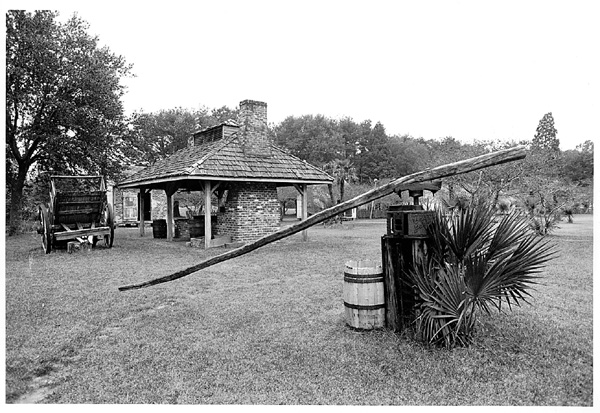
EARLY SUGAR PLANTATIONS
The sugarcane areas of Louisiana developed first along the Mississippi, both downriver and upriver from New Orleans. Sugar plantations were also established along the banks of Bayou Lafourche, Bayou Teche, and Bayou Terrebonne, and in the Red River valley of present-day Rapides Parish. Since waterborne transportation was the primary means of moving goods before the advent of railroads, nearly all the early sugar plantations fronted a navigable waterway. Planters soon learned what adjustments were necessary for cultivating a tropical plant in a semitropical climate and how to face the challenges posed by Louisiana's low-lying terrain. Word spread quickly of the profits to be made in sugarcane, and Anglo-Americans from other areas of the South and from the eastern seaboard joined the Creole planters after the United States acquired the Louisiana territory in 1803.
The method of producing cane sugar in early 19th-century Louisiana was largely derived from the 18th-century European sugar colonies in the Caribbean. Each cane plantation in Louisiana had its own sugarhouse. The cane was crushed using an animal-powered three-roller mill. The extracted cane juice was heated, clarified, and evaporated in a set of large open kettles of decreasing size which were enclosed in brickwork over a furnace. Lime was the substance most often used to clarify the cane juice, and the impurities that rose to the surface were skimmed off. After a syrup resulted from the evaporation of the juice, the sugarmaker, using rule-of-thumb techniques, determined when sugar crystals had formed. This was called a "strike" and was the point at which the concentrated syrup was turned out into shallow wooden tanks and left to cool. The crystallized mass was then placed in large barrels (hogsheads), each of which had several holes at the bottom that allowed the molasses to drain out. Molasses was collected in cisterns and later packed into separate barrels for market. The cane grinding season, or roulaison, was a festive time on most plantations. Social gatherings, dances, and candy pullings took place after the cane was ground, and visitors to plantation sugarhouses were often treated to "hot punch," a drink made of partially boiled cane juice and French brandy.
Items displayed in case 2:

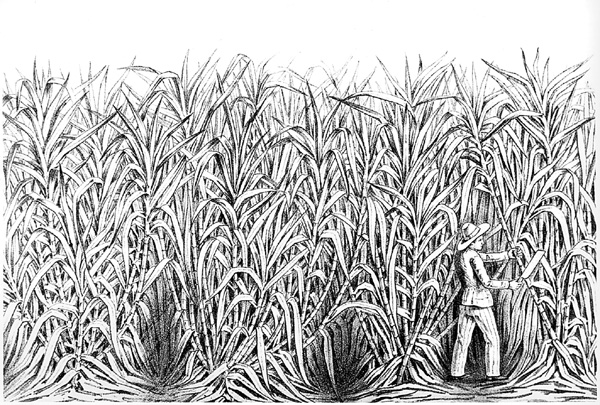
Letter from Mary C. Weeks to Alfred Conrad, 29 November 1820, reporting on "forty seven hogsheads of beautiful sugar" made at Weeks Island, Iberia Parish. David Weeks and Family Papers, Mss. 528, Louisiana and Lower Mississippi Valley Collections. The date 1802 on the letter is an apparent transposition by the writer, Mary Conrad Weeks, who was born in 1796 and married David Weeks in 1818.
Benjamin Silliman. Manual on the Cultivation of the Sugar Cane and the Fabrication and Refinement of Sugar. Washington, F.P. Blair, 1833. Louisiana Collection Rare TP377 S58
Plantation diary of Paul L. DeClouet, St. Martin Parish, 1867. Alexandre E. DeClouet and Family Papers, Mss. 74, Louisiana and Lower Mississippi Valley Collections
Letter from N. Wilson to Joseph Erwin, 21 February 1818, reporting on sugar production at Erwin's plantation in Iberville Parish. Edward J. Gay and Family Papers, Mss. 1295, Louisiana and Lower Mississippi Valley Collections
SUGAR AND MONEY
Antebellum Louisiana accounted for 95% of the sugar produced in the South. Although a few refineries existed, including the Louisiana Sugar Refining Company in New Orleans, refining was not a significant part of the antebellum sugar industry. Louisiana's product was chiefly raw sugar, most of which was shipped to cities in the upper Mississippi Valley either directly from the plantations or by way of New Orleans. Some of the sugar from the Teche region was shipped directly to East Coast ports. Packed in hogsheads marked with the name of the plantation on which it was made, the raw sugar that arrived in New Orleans by steamboat was sold daily at auction on the levee. Planters usually consigned their sugar to commission merchants, or factors, who often also played the role of financiers. Since sugarcane required greater capital investment than other crops and was unpredictable as well, planters were dependent on their factors for credit and on banks for the financing of plantation operations. Several planters' banks existed, including the state-chartered Consolidated Association of Planters of Louisiana, established in 1828. Planter-members who bought shares in the bank could be reasonably certain of obtaining loans.
Throughout the history of the Louisiana sugar industry, import tariffs on foreign sugar have affected the profitability of Louisiana sugar. Increased tariff protection in the 1820's and 1840's, for example, led to dramatic rises in the number of sugar plantations. Louisiana's sugar interests sought to persuade federal officials to maintain favorable tariffs since the early years of the industry. Tariffs were often a contentious issue in national politics throughout the 19th century, and tariff reductions for imported sugar always drew negative reactions from Louisiana planters concerned about the profitability of their own product.
Items displayed in case 3:
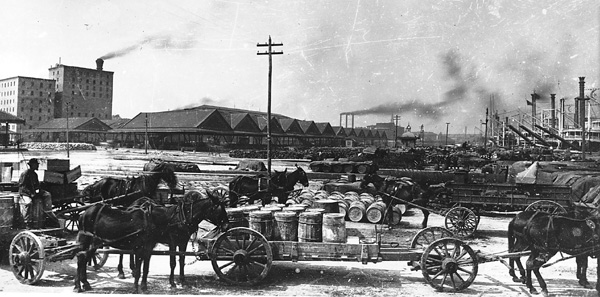
Plantation sugar house, 1850's, and Sugar mill, 1850's. Reproduced from Harper's New Monthly Magazine, November 1853. Middleton Library AP2 H3
New Orleans levee. Reproduced from: Harper's Weekly, March 30, 1861. Rare Flat 051 H234
Sugar auction announcement, 1861. Loan, LSU Rural Life Museum
Steamboat bill of lading, 27 January 1869, for a sugar shipment from Assumption Parish to New Orleans. Severin Landry and Family Papers, Mss. 210, Louisiana and Lower Mississippi Valley Collections
P.A. Champomier. Statement of the Sugar Crop Made in Louisiana . New Orleans, 1855. Louisiana Collection HD9107 L8 C5 c.5
Letter from Edward J. Gay to Col. Andrew Hynes, 26 November 1842, giving account of sugar sales at St. Louis on behalf of Hynes & Craighead of Iberville Parish. Edward J. Gay and Family Papers, Mss. 1295, Louisiana and Lower Mississippi Valley Collections
Bank deposit book of Fauche Cougot, 1835-1836. Consolidated Association of Planters of Louisiana Papers, Mss. 82, Louisiana and Lower Mississippi Valley Collections
Josiah S. Johnston. Letter of Mr. Johnston of Louisiana to the Secretary of the Treasury. Washington, 1831. Louisiana Collection Rare SB231 J7 c.1
BEGINNINGS OF TECHNOLOGICAL CHANGE
During most of the 19th century, technical innovations were adopted slowly in the Louisiana sugar industry. Planters in antebellum Louisiana generally lacked scientific knowledge, and no local institutions existed to train people to operate or repair new types of devices. Progressive planters looked mainly to France for scientific and technical knowledge. Several French-educated scientists were instrumental in introducing early improvements in Louisiana's sugar industry. J.B. Avequin, a New Orleans apothecary, studied sugarcane chemistry to determine milling efficiency and published his findings in French scientific journals. De Bow's Review, an influential periodical published in New Orleans beginning in 1846, reprinted French articles on scientific aspects of sugar manufacture and espoused progressive views regarding the role of science.
Steam power, the first 19th-century innovation in sugar manufacture, was introduced to the Louisiana sugar industry in 1822 with the importation of the state's first steam-powered cane mill. Steam engines gradually began supplanting animal power for mills during the 1830's and 1840's. Steam vacuum pans, invented in England, were first used on several Louisiana plantations in the 1830's. Early vacuum pans were closed vessels with double bottoms, in which cane juice was heated and evaporated under reduced pressure. This was more efficient than the open-kettle method and also yielded a higher quality sugar. The vacuum pan design was enlarged and improved by Norbert Rillieux (1806-1894), a free person of color born in New Orleans and educated in France. Rillieux's invention was the multiple-effect evaporation system, linking several vessels by a series of steam chambers so that each vessel after the first was heated by the vapor from the preceding one. Rillieux's design significantly reduced fuel consumption and is considered the most important innovation in 19th-century sugar manufacturing technology. Multiple-effect evaporation was first used in Louisiana and then spread to other parts of the world.
Another fuel-saving innovation, introduced in Louisiana in the 1850's, was the bagasse furnace. Bagasse, the residue of milled cane, began to replace wood as a fuel in Louisiana sugarhouses. Just before the Civil War, a few Louisiana plantations also switched from the barrel drainage method of purging molasses to the use of centrifugals. Adopted from the European beet-sugar industry, these screened vessels rotated at high speed, retaining the crystallized sugar while allowing the molasses to escape. Centrifugals reduced the amount of time required for purging and yielded a drier raw sugar.
Items displayed in case 4:

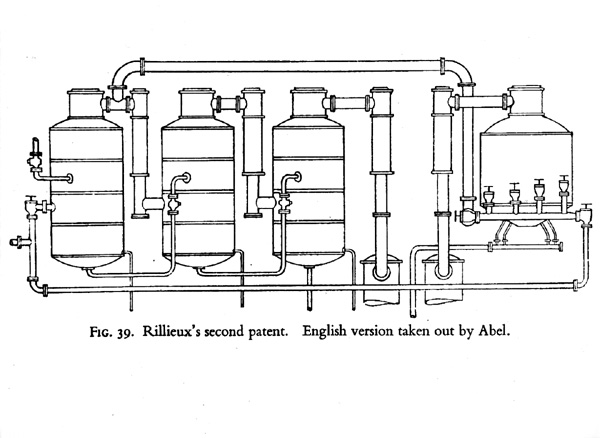

"Oaks's Apparatus," Vacuum pan design, circa 1832. Reproduced from: Benjamin Silliman. Manual on the Cultivation of the Sugar Cane and the Fabrication and Refinement of Sugar. Washington, F.P. Blair, 1833. Louisiana Collection Rare TP377 S58
Manuel pratique pour la fabrication du sucre de canne. Paris, Rignoux, 1845. Rare TP377 A53 1845
The Commercial Review of the South and West (De Bow's Review), v. 4. New Orleans, 1847. Louisiana Collection HF1 D2 c.3
"Moses Thompson's Furnace ..." Bagasse furnace design, 1850's. Reproduced from the original in David Weeks and Family Papers, Mss. 528, Louisiana and Lower Mississippi Valley Collections
J.B. Avequin. "Sur la matire cireuse de la canne `a sucre," Annales de chimie et de physique, 2nd series, v. 75 (1840). Chemistry Library QD1 A7
DEVASTATION AND TRANSITION
During the Civil War, most of Louisiana's sugar parishes came under the control of Union forces by the end of 1863. Some planter families fled to Texas, and wartime conditions in Louisiana caused such widespread physical destruction, financial ruin, and social disruption, that many plantations and other sugar-related enterprises did not survive the war. Some plantations passed to new owners, among whom were Northern investors as well as Louisiana businessmen not previously involved in the sugar industry. The transition from a slave economy to a wage labor system involved many struggles and adjustments. Beginning around 1870, immigrant laborers including Chinese, Swedes, Spaniards, and Italians were employed in the cane fields for brief periods. African Americans nevertheless still constituted the majority of cane workers, and their struggles for better wages continued into the 20th century.
Planting, cultivation, and harvesting of sugarcane continued to be done entirely by hand in the latter 19th century. Several new agricultural implements were introduced, including some developed in Louisiana, such as cane cultivators, stubble shavers and stubble diggers. Aids for loading, unloading, and lifting cut cane--slings and derricks--were also first used in the late 19th century. Milling and processing began taking place on a larger scale with the introduction of new mill designs and improved methods for cane juice extraction and clarification. Many of the advances in process equipment during this period originated in Germany's beet-sugar industry. German ideas introduced into Louisiana during the late 19th century included detailed record-keeping techniques and the application of chemical science to sugar production. Sugarhouse chemists initially faced considerable opposition from sugar boilers and other mill workers who employed only traditional methods handed down on the job, but ultimately chemical control completely transformed business practices in the Louisiana sugar industry.
Items displayed in case 5:
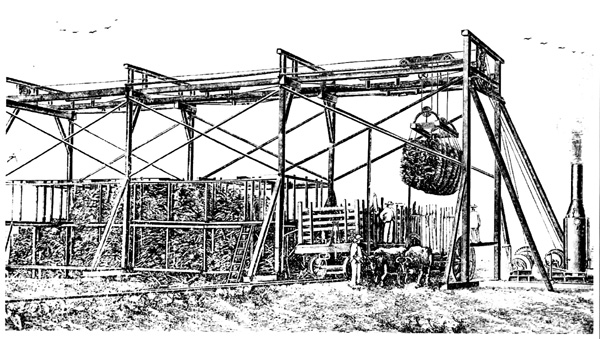
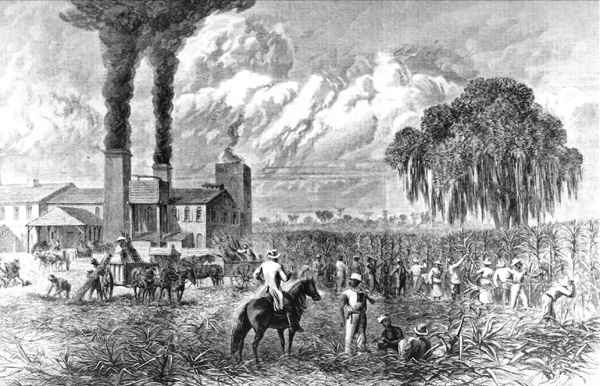
Disc cultivator. Reproduced from: Noel Deerr. Cane Sugar. London, Norman Rodger, 1921. Louisiana Collection SB231 D5 1921 c.2
Cane mill, 1870's. Reproduced from: Isaac Hedges. Sugar Canes and Their Products, Culture and Manufacture. St. Louis, 1879. Louisiana Collection TP405 H46
Freedmen's Bureau circular, 4 December 1865. Severin Landry and Family Papers, Mss. 210, Louisiana and Lower Mississippi Valley Collections
German designs for sugar factory vessels. F. Stohmann. Handbuch der Zuckerfabrikation. Berlin, Wiegandt, Hempel & Parey, 1878. Rare TP377 S76
Advertisement for cane-juice sulphur bleacher, circa 1878. Edward J. Gay and Family Papers, Mss. 1295, Louisiana and Lower Mississippi Valley Collections
Hydraulic pressure regulator for sugar mills, 1880's. Reproduced from: Louisiana Sugar Planters' Association. Regular Monthly Meeting, August 1887. New Orleans, 1887. Louisiana Collection SB215 L6863
B.F. Avery stubble digger. Reproduced from: J.B. Wilkinson. The Diffusion Process in Louisiana and Texas. New Orleans, L. Graham, 1889. Louisiana Collection TP382 W55
Lezin A. Becnel. Report on the Results of Belle Alliance, Evan Hall and Souvenir Sugar Houses for the Crop of 1888. New Orleans, L. Graham, 1889. Louisiana Collection HD9107 B44 1889
